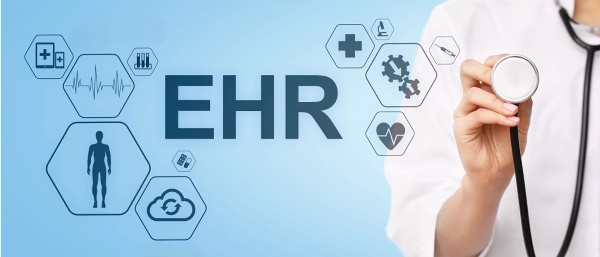university.nakul@gmail.com | Posted on
Electronic Health Record (EHR) technology is a highly sophisticated electronic tool that has been meticulously crafted in order to securely store, retrieve, and communicate vital patient medical information in multiple healthcare settings. In comparison with the paper charts that are often maintained, the EHR provides an all-inclusive, live, and conveniently accessible platform from which healthcare providers can record, retrieve, and manage patient health information with ease. The sophisticated technology has established itself as an essential support in contemporary healthcare regimes, significantly influencing the way physicians deliver care, monitor and trace patient developments, and promote collaborative efforts between diverse healthcare institutions.

Definition of EHR Software
EHR software, or Electronic Health Record software, is an advanced computerized system that efficiently replaces outdated physical charts with electronic records. The electronic records have complete information regarding a patient's medical history, including their past diagnoses, medications, complete treatment plans, immunization, known allergies, laboratory tests, and an assortment of other relevant health information. The system is not only intended to gather simple clinical information but also to enhance its capacities by integrating advanced tools to improve decision-making, to facilitate interoperability among different systems, and to encourage increased patient participation in their own health care. EHRs must be realized as distinct and separate from so-called Electronic Medical Records (EMRs). EMRs are generally narrow in scope and are confined to the activities of a single practice or provider, while EHRs are specifically designed to facilitate broader sharing and access of health information by several healthcare organizations and systems.
Core Features of EHR Software
EHR systems come equipped with a variety of features tailored to improve healthcare delivery. These include:
- Patient Charting: Allows providers to document visits, symptoms, and treatments digitally in real time.
- Interoperability: Enables secure data exchange between hospitals, clinics, pharmacies, and labs.
- Clinical Decision Support: Offers alerts, reminders, and evidence-based recommendations to assist providers in making informed decisions.
- E-Prescribing: Facilitates electronic submission of prescriptions to pharmacies, reducing errors from handwritten notes.
- Billing and Coding: Integrates with financial systems to streamline insurance claims and payments.
- Patient Portals: Provides patients access to their records, appointment scheduling, and communication with providers.
These features collectively aim to enhance efficiency, reduce redundancies, and improve patient outcomes.
Benefits of EHR Software in Healthcare
The adoption of EHR software has brought significant advantages to the healthcare industry:
- Improved Patient Care: With instant access to a patient’s complete medical history, providers can make faster, more accurate diagnoses and tailor treatments effectively.
- Enhanced Coordination: EHRs enable seamless collaboration among specialists, primary care physicians, and other stakeholders, especially for patients with complex or chronic conditions.
- Reduction in Errors: Digitized records minimize risks associated with illegible handwriting, lost files, or misplaced information.
- Time and Cost Efficiency: Automation of repetitive tasks like scheduling and billing reduces administrative burdens and operational costs over time.
- Data Analytics: EHRs allow healthcare organizations to analyze trends, track population health, and improve overall care quality through data-driven insights.
Challenges of Implementing EHR Software
Even though it is beneficial, adopting EHR is challenging:
- Unaffordable Upfront Costs: Buying, implementing, and educating personnel for EHR systems is costly, especially for small practices.
- Learning Curve: It takes time and training to shift from paper to computer systems, disrupting processes in the short term.
- Threats to Data Security: Similar to any internet system, EHRs are under threat from cyberattacks, which compromise patient confidentiality and regulatory compliance under the HIPAA (Health Insurance Portability and Accountability Act) regulations.
- Interoperability Problems: The communication effectiveness between dissimilar EHR systems varies, leading to cases of data sharing in pieces.
These issues can be addressed by effective planning, strong cybersecurity, and ongoing support of healthcare staff.
EHR Software and Regulatory Compliance
In every country, EHR systems must fulfill very strict legal and regulatory requirements. In the United States, for example, the Health Information Technology for Economic and Clinical Health (HITECH) Act encourages the implementation of EHRs but requires patient information protection. HIPAA compliance provides patient security and confidentiality. Certified EHR software generally adheres to these, allowing healthcare organizations to escape fines while sustaining public confidence.
The Future of EHR Software
The evolution of Electronic Health Record (EHR) technology is itself shaping the healthcare future. Technologies such as artificial intelligence (AI) adoption, telehealth readiness, and wearables integration are expanding the scope of what can be accomplished within EHR systems. For instance, AI may examine large amounts of EHR data to identify patient outcomes or identify possible concerns before they can become critical. Meanwhile, patient engagement applications like mobile applications coupled with EHRs enable patients to be an active participant in their healthcare.
Conclusion
EHR software is a deeply disruptive technology within the medical field, far bridging the divide between traditional methods of keeping records and the new patient-focused paradigm. By electronically digitizing patient information and integrating it into one combined platform, EHR software revolutionizes clinical productivity, promotes greater coordination among medical professionals, and ultimately facilitates the achievement of enhanced patient health outcomes. Despite current challenges, including continued issues regarding cost and security, future breakthroughs within the space guarantee increased integration of EHR systems within the medical field, further entrenching them as vital tools. As of March 27, 2025, it is clear that EHR software continues to be a vital part within an ever-changing medical field, actively driving change that advantages healthcare professionals and patients in a meaningful way.
0
0 Comment
